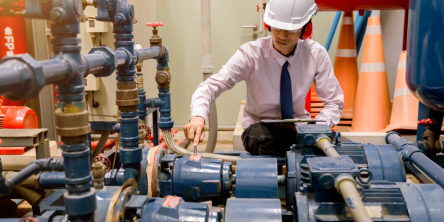Server Racks Made Simple for Small Businesses

Are you finding it challenging to manage your growing IT infrastructure as a small business owner? With business expansion comes the need to effectively organize and protect your essential networking equipment.
Server racks provide a solution, but the world of IT hardware can be daunting. This guide will demystify server racks, helping you make informed decisions to create an efficient, secure, and scalable IT environment that supports your business.
What are Server Racks?
Server racks are metal frames designed to hold, organize, and protect various IT equipment such as servers, switches, routers, and storage devices. A server rack is essentially a standardized frame or enclosure that allows you to mount multiple pieces of equipment vertically. This design maximizes space efficiency and helps keep your IT equipment organized and secure.
Server racks provide several benefits. They keep your equipment neatly arranged and easily accessible, provide proper airflow management to prevent overheating, and often include locking mechanisms to protect valuable equipment.
Accessories such as cable management arms, blanking panels, and cooling fans can further enhance the functionality of your server rack. A server rack shelf 1U, which fits within a single rack unit space, can be useful for holding non-rack-mountable equipment or providing additional stability for smaller devices.
As your business grows, you can easily add more equipment to the rack. Additionally, racks help keep cables tidy and prevent tangling.
Types of Server Racks
There are several types of server racks, each suited to different needs and environments.
Open-frame racks lack sides or doors, allowing for maximum airflow and easy access to equipment. They are ideal for well-secured server rooms where physical security is not a major concern.
Enclosed racks have sides and doors, offering better physical security and protection from dust. They are suitable for environments requiring extra protection for equipment or noise reduction.
Wall-mount racks are ideal for small spaces. They can be mounted on a wall, saving valuable floor space. These are perfect for small offices or retail environments with limited room.
Portable racks are designed for mobility, making them useful for businesses that frequently move equipment or need temporary setups.
| Feature | Open Frame Rack | Enclosed Rack | Wall-Mount Rack | Portable Rack |
| Airflow | Excellent | Good (with ventilation) | Limited | Varies |
| Security | Low | High | Moderate | Moderate |
| Space Efficiency | Moderate | High | Excellent | Good |
| Mobility | Low | Low | None | Excellent |
| Noise Reduction | Poor | Good | Moderate | Varies |
| Typical Use Case | Secure server rooms | Office environments | Small spaces | Temporary setups |
Sizing Your Server Rack
Choosing the right size rack is crucial for meeting current needs and allowing for future growth. Server racks are measured in rack units, or "U". One U is equal to 1.75 inches (44.45mm) in height. Common rack sizes range from 12U to 42U. For example, a 42U rack is about 6 feet tall.
The standard width for most racks is 19 inches, which accommodates most server equipment. Depth can vary, typically ranging from 24 to 48 inches. Consider the depth of your deepest piece of equipment when choosing a rack.
When sizing your rack, always plan for future growth. Having extra space is better than outgrowing your rack too quickly.
Essential Features to Consider
When choosing a server rack, several features can enhance its functionality and ease of use.
Cooling Options
Proper cooling is essential for the longevity of your equipment. Look for racks with good ventilation or built-in cooling systems. Some racks come with fan kits or can accommodate additional cooling units.
Cable Management
Effective cable management keeps your setup organized and enhances airflow. Seek racks with built-in cable management features such as vertical cable channels or cable ties.
Power Distribution
Many racks come with or can accommodate power distribution units (PDUs). These allow you to efficiently power multiple devices and often provide surge protection.
Adjustable Rails
Adjustable mounting rails allow you to accommodate equipment of different depths, providing flexibility in your setup.
Security Features
For physical security, choose racks with lockable doors and side panels. Some racks also offer keyed locks for individual sections.
Setting Up Your Server Rack
Proper setup of your server rack is crucial for optimal performance and longevity of your equipment. Position your rack in a clean, cool, and dry environment. Avoid areas prone to dust, heat, or moisture. Ensure there is enough space around the rack for proper ventilation and access.
Ensure your rack is properly grounded to protect against electrical hazards and reduce electromagnetic interference. Place heavier equipment at the bottom of the rack for stability. Arrange equipment to optimize airflow, usually with a front-to-back pattern.
Maintaining Your Server Rack
Regular maintenance of your server rack ensures optimal performance and longevity of your equipment. Dust and debris can impact equipment performance and lifespan. Regularly clean your rack and equipment using compressed air and anti-static cloths.
Monitor the temperature inside your rack regularly. Overheating can cause equipment failure and data loss. Consider installing temperature sensors if your rack lacks built-in monitoring.
Regularly inspect your equipment for signs of wear or damage. Check for loose connections, frayed cables, or unusual noises from fans or hard drives. Keep all your equipment's firmware and software up to date. This ensures you have the latest security patches and performance improvements.
Common Challenges and Solutions
Even with careful planning, you may encounter some challenges with your server rack setup. Address overheating by improving ventilation, adding cooling fans, or upgrading to a rack with better airflow management.
Manage cable clutter by implementing a structured cabling system, using appropriately length cables, and utilizing cable management accessories. If space is limited, consider wall-mount racks or compact enclosed racks. Optimize your equipment layout to maximize space efficiency.
If noise is an issue, consider an enclosed rack with sound-dampening features or relocate the rack to a less sensitive area. For power management challenges, use PDUs with adequate outlets and consider implementing a UPS (Uninterruptible Power Supply) for critical equipment.
Cost Considerations
The cost of setting up a server rack can vary widely based on your needs and choices.
Initial Costs
The rack itself can range from a few hundred dollars for a basic open-frame rack to several thousand for a high-end enclosed rack with advanced features. Don't forget to factor in the cost of additional accessories such as PDUs, cooling systems, and cable management solutions.
Operational Costs
Consider ongoing costs such as electricity for powering and cooling your equipment. Efficient cooling and power management can help reduce these costs over time.
To save costs, start with a slightly larger rack than you currently need to accommodate future growth. Invest in quality cable management to save time and hassle over the long term. Consider energy-efficient equipment to reduce operational costs. Regular maintenance can prevent costly equipment failures.
When to Seek Professional Help
While many small businesses can manage basic server rack setup and maintenance, there are times when professional help is advisable. This includes complex installations with many racks and advanced cooling. They also include significant electrical work for power distribution.
You should call if you're unsure about proper grounding or other safety when setting up advanced networks. Additionally, if you're experiencing persistent issues with overheating or equipment failure.
Conclusion
Implementing a well-organized server rack system is essential for your small business's IT infrastructure. Understanding server rack basics, benefits, and best practices equips you to make informed decisions supporting your business's growth and efficiency.
As your IT requirements change and expand, stay informed about new technologies and be prepared to update your setup. With the right approach to server rack management, you are building a strong foundation for your business's digital future, ensuring scalability, security, and optimal performance of your networking equipment.
Frequently Asked Questions
What are the benefits of using a server rack?
Server racks improve organization, enhance cooling, increase security, simplify cable management, and enable easy scalability. They also protect equipment from dust and physical damage, extending its lifespan.
Do I need a professional to set up my server rack?
For basic setups, many small businesses can manage installation themselves. However, professional help is advisable for complex installations, significant electrical work, advanced networking configurations, or persistent equipment issues.
How can I maintain my server rack properly?
Regularly clean the rack and equipment, monitor temperature, check for loose connections or damaged components, keep software updated, and manage cables effectively. Implement a routine maintenance schedule for optimal performance.
Similar Articles
Managing finances as a small business owner can be challenging. Without a steady salary, handling income fluctuations, taxes, and expenses requires careful planning.
Do you know which is a thing that you need to consider before launching a product? A powerful first impression is what most people ignore.
Have you ever wondered how pipeline investigations are conducted, particularly in hard-to-reach areas or amidst complex landscapes? How does technology come into play in ensuring safe and efficient pipeline inspections?
Running a small business is like juggling flaming torches while riding a unicycle—you’ve got a lot going on, and one misstep can get messy fast. Nowhere is this truer than in the realm of small business accounting. Sure, numbers don’t lie, but they can be sneaky little devils if you’re not careful.
As the bare branches of winter give way to the full bloom of spring, many homeowners find themselves considering some much-needed tree maintenance. Which trees need trimming? Which ones pose a risk due to overhanging branches, or a developing lean? More crucially, how do you differentiate between the various types of tree cutting services available?
Small businesses face more cyber threats than ever. Cybercriminals often target these enterprises, knowing they may lack robust security measures. According to the Identity Theft Resource Center (ITRC), about 3 in 4 small businesses reported a cyberattack last year
Due to today's competitive environment, small businesses have a hard time distinguishing themselves from their numerous rivals in today's market. One key factor that defines their fate usually is branding
Looking to start a profitable small business? Discover 5 laser engraved products that are in high demand. These ideas are perfect for those seeking a creative and rewarding venture.
It’s crucial to target more skincare users as it can contribute to business expansion along with sales growth. As competition rises in the skincare sector, identifying ways to engage consumers is critical as the market grows stiff. These are some best practices that may be of great help in attracting new skincare clients and keeping them coming back for more.









